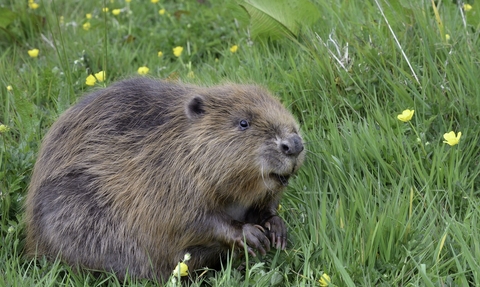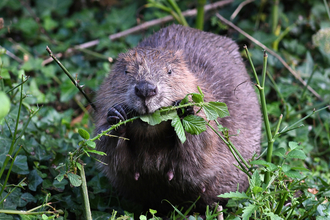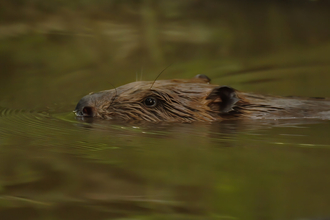
Beaver. Credit: Nick Upton/Cornwall Wildlife Trust
Beavers
For hundreds of years, the furry, paddle-tailed figure of the Eurasian beaver (Castor fiber) has been missing from the rivers of the UK. The Eurasian beaver is a large herbivore, a mammal that is native to these shores and was once widespread. Beavers played a crucial role in our wetland landscapes from prehistoric times until it was hunted to extinction in the 16th century for its fur, meat and scent glands. The loss of this charismatic species also led to loss of the mosaic of lakes, meres, mires, tarns and boggy places that it so brilliantly built.
Following the successful conclusion of the 5-year River Otter Beaver Trial (ROBT) in Devon which studied the impacts of wild and free living beaver; in August 2020 the government announced that the beavers could remain on the River Otter permanently and spread naturally from there. This marked the first authorised reintroduction of a mammal into England and followed a similar decision in Scotland in 2016.
Beavers are recognised as a native species and finally became protected on 1st October 2022.
Wiltshire Wildlife Trust welcomes the protection for “nature’s engineers”, and we join calls for support and incentives for landowners to make space for beavers on their land.
Beavers are key to creating thriving wetland ecosystems – which are critical for climate adaptation –and provide a wealth of benefits for nature and people, such as holding water back in the landscape, reducing the risk of wildfires and reducing the risk of flooding downstream.
The benefits of beavers
This isn't just about the reintroduction of a species - it's about the reintroduction of an entire ecosystem that's been lost.
Beavers are often referred to as 'ecosystem engineers'. They make changes to their habitats, such as coppicing trees and shrub species, damming smaller water courses, and digging 'beaver canal' systems. These activities create diverse and dynamic wetlands - helping to connect floodplains with their watercourses once again.
The impressive and ever-growing body of independent scientific evidence reveals the vast array of benefits that beavers, and the landscapes they generate, can bring to both people and wildlife.
These include:
- Improved water quality: Beaver dams slow and filter water, causing sediment and nutrients to be deposited in ponds. This improves the quality of water flowing from sites where beavers are present.
- Land holds more water: The dams, ponds and channels created by beavers increase capacity of land to store water and produce a more consistent outflow below their dams. This can result in less water being released during heavy rainfall (reducing flooding downstream) and more water availability during times of drought.
- Carbon is captured: Beaver wetlands capture carbon, locked up in dams, and boggy vegetation and wet woodlands which are restored.
- More wildlife: Beavers create diverse wetland habitats that can bring enormous benefits to other species, such as otters, water shrews, water voles, birds, invertebrates (especially dragonflies) and breeding fish
- People engaged with wildlife: People are fascinated by beavers. The presence of beavers in an area provides an opportunity for people to engage with wildlife, as well as creating a market for nature tourism.
Beavers create thriving ecosystems helping us to put nature firmly back on the road to recovery. And they do all this for free.
Log your beaver sighting
If you do spot signs of a beaver in the wild in Wiltshire please let us know!
Spotter's guide - what are the signs of beavers?
- Beaver lodge - a large pile of branches beside a watercourse can be a sign that a beaver is in residence.
- Gnawed wood – look out for wood that's been chewed, possibly with associated woodchips.
- Pencil tip – a log or branch gnawed to a point is a sure sign there are beavers about.
- Footprint – Beaver footprints are large and long. A clear print will display the outline of the web of skin connecting the toes.
Let us know about your beaver sightings using IRecord here. This feeds into the records held by Wiltshire and Swindon Biological Records Centre.
Beaver FAQ's
What experience is there from beavers in Europe?
Reintroductions and translocations of Eurasian beaver have now taken place in more than 25 European countries. They began in the 1920s in Sweden, Norway, Latvia, Russia and the Ukraine and continued throughout the 1980s and 1990s in the Netherlands, Croatia, Bosnia and Herzegovina, Czech Republic, Denmark, Hungary, Romania and Slovakia.
Reintroductions usually involve the release of animals over a number of years to several sites. Most have been successful in terms of breeding, population growth and range expansion.
More than 150 translocations have now been undertaken across Europe, most without the detailed monitoring carried out by the Scottish Beaver Trial and other British projects, but some have been thoroughly studied, enabling scientists to predict with confidence the likely pattern of events post reintroduction. Experts and volunteers across Europe are able to manage problems that sometimes occur, for example in areas of arable production.
Are there any beaver reintroduction projects in the UK?
Some Wildlife Trusts across the UK have successfully released beavers in their areas. This also includes two wild releases - the Scottish Beaver Trial and River Otter Beaver Trial. Through these trials, Wildlife Trusts have gained excellent insights and knowledge of beavers in the wider landscape, both of which have been backed by independent scientific evidence.
Find out more about reintroduction projects around Britain from different Wildlife Trusts below. This includes a report by The Wildlife Trusts about beaver reintroductions and a report from Devon Wildlife Trust looking at the River Otter Beaver Trial - a 5-year trial reintroduction of Eurasian beavers into the wild in south east Devon.
Are beavers already in Wiltshire?
Yes, wild beavers are already present in some of our rivers and wetlands, and we will increase monitoring of beavers on our waterways to determine their impact.
Beaver populations typically spread very slowly. They are shy and keep a low profile and in many areas they can go for a long period before their activity is noticed. They are very territorial and this regulates their populations - even killing rival beavers if they stray on their patch. They only breed once a year and have an average of three kits which are vulnerable to predation. Their numbers don’t extend in a prolific manner. And once they are present, they do not move far from rivers and streams so their activity is largely restricted to approximately 30m away from their water source.
Does the Trust have any plans to reintroduce beavers?
No, Wiltshire Wildlife Trust does not currently have any beaver reintroduction/release plans in the county. However, we are exploring a whole range of nature based solutions to tackle the ecological and climate crises, and we cannot rule out beaver reintroductions in the future as part of this wider approach. Currently, a lot of our work is focused on restoring wetlands and rivers, and these habitat enhancements will benefit beavers alongside a host of other wetland species.
There is now much evidence to demonstrate that as a natural ‘ecosystem engineer’ beavers can deliver multiple positive benefits for biodiversity, alongside alleviating the impacts of climate change, flooding, droughts and pollution. Beavers are key to creating thriving wetland ecosystems, and so we support the beaver reintroduction projects taking place at other Wildlife Trusts across the UK.
What are the environmental impacts of beavers?
Beavers can modify the habitats and landscapes they live in through coppicing, feeding and in some cases damming (beavers living on lakes or rivers have little need of constructing dams). However in many cases when they are living at low density, their impacts can be remarkably subtle and go unnoticed for many years.
Evidence from Europe shows that shows that beaver impacts are, in the vast majority of cases, small-scale and localised. Beavers are not normally regarded as pests in Europe and where localised problems have occurred, there are a number of well-established mitigation methods that have been adopted. These include the removal of dams, the introduction of overflow piping, or the installation of fencing (as one does for deer and rabbits). In some cases, the removal and translocation of beavers could be considered. Some countries with sustainable beaver populations permit seasonal hunting and/or lethal control as legitimate management strategies.
What impact do beavers have on trees?
As herbivores, beavers eat a wide range of vegetation and this can include trees. They forage close to water with activity usually concentrated within 20 metres of the water’s edge. Beavers do selectively fell broad-leaved trees and bushes to reach upper branches, to encourage regrowth, to eat the bark during the winter and to construct their lodges and dams.
Many tree species regenerate, which diversifies the surrounding habitat structure and create areas of mixed-height, mixed-age vegetation that benefits many wildlife species. Coppicing has been practiced by foresters throughout history as a method to manage bankside trees. The actions of beavers are very similar, meaning woodlands and trees are more naturally managed. Where needed, there are methods to protect special trees from unwanted attention from beavers including mesh guards and anti-game paint.
Beavers rarely eat conifers, although the odd conifer might be gnawed by an immature animal that has not learned that conifers are unpalatable and that its resin gums up their teeth. They generally do not live in water entirely surrounded by conifers.
What impact do beavers have on water management?
By creating dams and associated wetlands in headwater streams, beavers store floodwater in upper catchments, moderating water flows. This reduces the height of flood peaks and also ameliorates low flows during dry periods as the leaking dams recharge streams with fresh constant flows. For those landowners impacted, these dams can cause localised “flooding” or raised water levels in wetland habitats. The size of these ponds and wetlands can be restricted by the use of flow devices where pipes set the maximum height of the dam, and thus the area of land flooded.
Beavers rarely build dams in main rivers downstream where there is sufficient depth of water, and so many of the concerns about flooding are not real. However in low lying floodplains where agricultural activities depend on land drains and deep ditches, beaver dams can have more significant impacts. They can obstruct culverts and “restore wetlands” in places that are not compatible with the existing land-uses and therefore create real, and perceived conflicts.
Evidence from elsewhere in Europe shows that instances of beaver dams creating undesirable flooding are uncommon, localised and usually small-scale. In these situations dams are simply removed or pipes (‘beaver deceivers’) are placed through them to manage water levels.
What impact do beavers have on fish?
Beavers are herbivorous, so do not eat fish. Habitat modification by beavers, however, could have impacts on fish populations in some circumstances, and fisheries groups may be concerned about the potential impact of beaver dams on the movement of migratory fish.
The interaction between beaver activity and freshwater fisheries has been the subject of several reviews. Based on the combined results of an independent and systematic review of the literature and survey of expert opinion, Kemp et al. (2012) concluded that:
Benefits (184) were cited more frequently than costs (119)
Impacts were spatially and temporally variable and differed with species.
The most frequently cited benefits of beaver dams were increased habitat heterogeneity, rearing and overwintering habitat; flow refuge; and invertebrate production.
The most frequently cited negative impacts were impeded fish movement because of dams; siltation of spawning gravels (particularly for salmonids); and low oxygen levels in ponds.
The majority of 49 North American and European experts (more than 60% of whom described themselves as fisheries scientists or managers) considered beavers to have an overall positive impact on fish populations, through their influence on abundance and productivity.
Is there any guidance on beaver management?
Wildlife licences are usually required by farmers, landowners, fishery managers, foresters and land or water managers to modify or remove beaver dams.
Actions to prevent beaver problems that may be taken by landowners without a license can include:
- Leaving a 10-30m buffer strip or making a natural space for beavers near the water’s edge
- Installing beaver fencing (permission from the local risk management authority may be required)
- Using tree protection
Visit the Natural England website to find out more about beaver licence requirements and what other actions can be taken by landowners without a license.
Or contact Natural England directly here.
Did you know? Myth-busting facts
- Beavers are vegetarians. They do not eat fish. In fact, they are known to co-exist well with them, boosting fish populations. Beavers snack on riverside plants, grasses, as well as tree bark and shoots.
- Beavers feel safest in still, deep water (around 70cm). They are very unlikely to stray far from it and will create dams if the water levels aren't as deep as they would like them to be.
- Where beavers go – more wildlife will follow. Beavers create diverse wetland habitats that can provide a home for a wide range of wildlife such as amphibians, water voles, dragonflies, birds and even plants.
- Eurasian beaver dams vary in size and structure. In many cases they are small temporary structures made of twigs, which gradually break down as water levels rise. In others, they can be larger stable structures that create big ponds. Both water and fish are able to move through and around them and they are not the huge dam structures made by the North American beaver.
- Beavers can reduce flooding. Beaver dams slow the flow of water; in storms more water is stored; in droughts more water is available. The potential for beavers to reduce flooding and maintain baseflows downstream is significant.
- Beavers can improve water quality. Impoundment of water behind dams can positively affect the quality of water by diffusing pollutants being transported downstream. Their dams act as sediment traps cleaning our waters.
What do I do if I find a sick or injured beaver?
Contact Oak and Furrows on 01793 640136 (option 2 then option 5).
They can offer an initial assessment and first aid, and will then contact RSPCA Wildlife department to arrange transport to a more suitable rehab facility. Oak and Furrows are currently able to house beavers for 24 hours.


